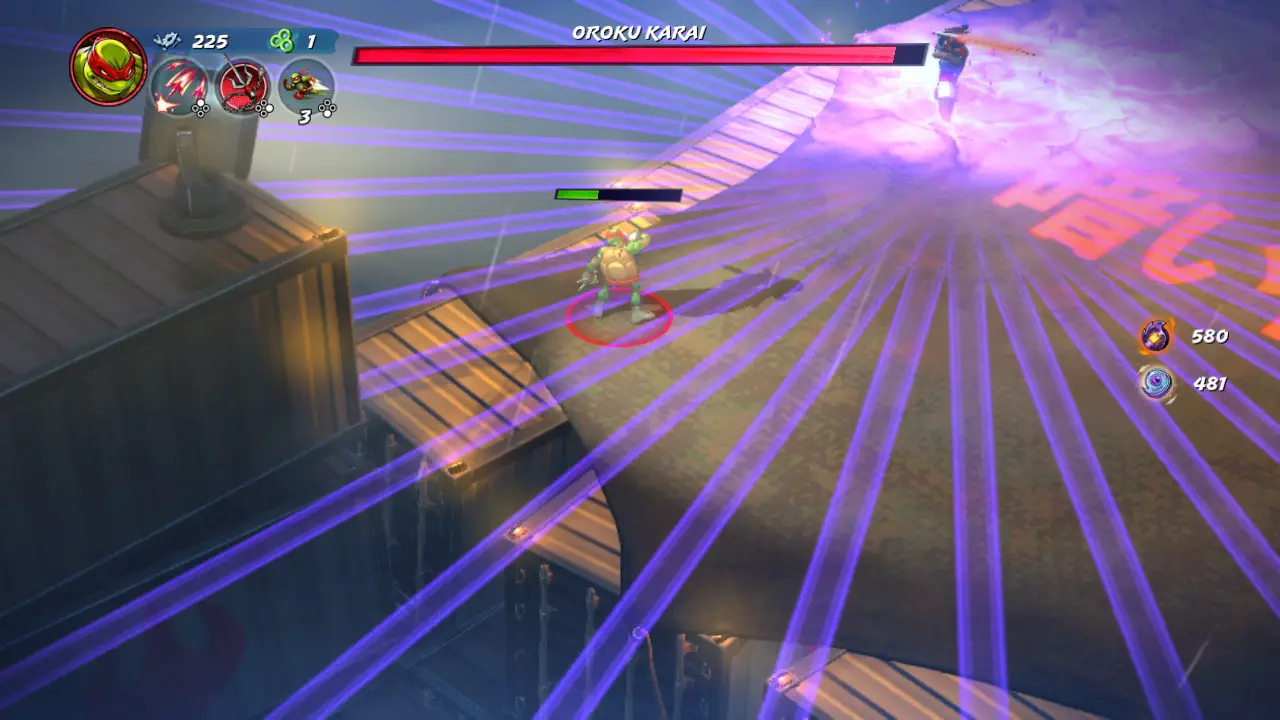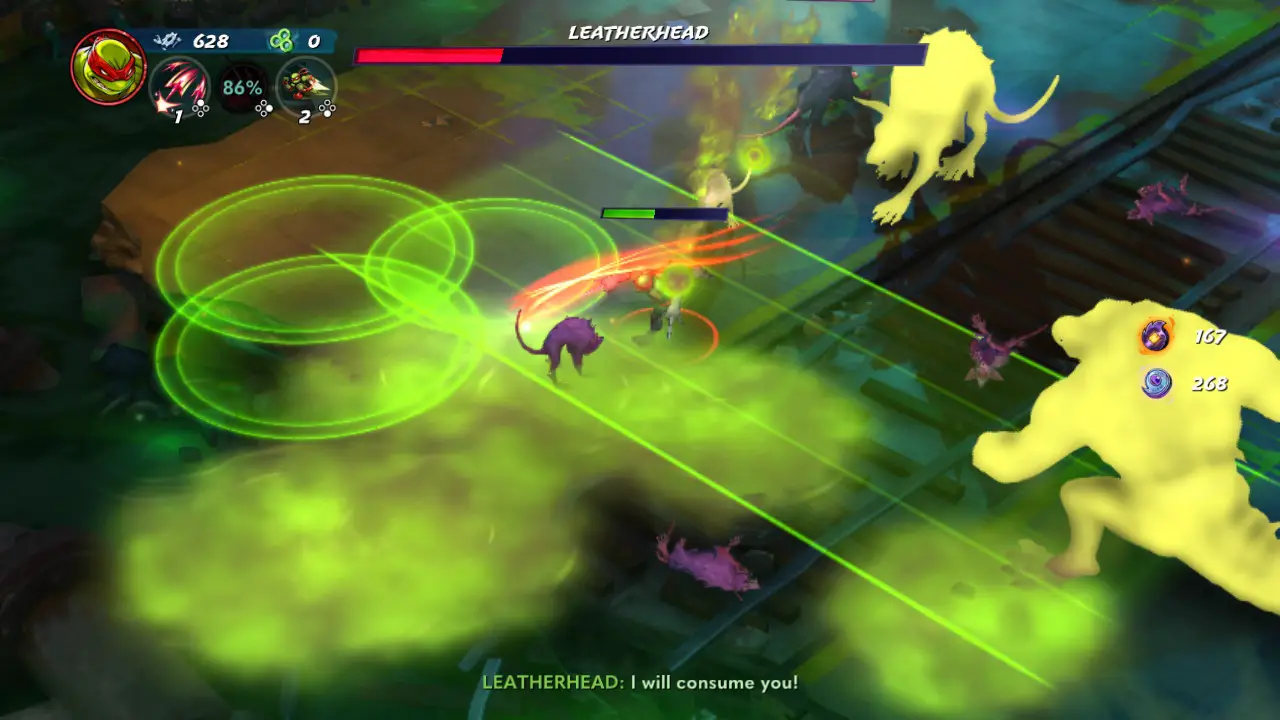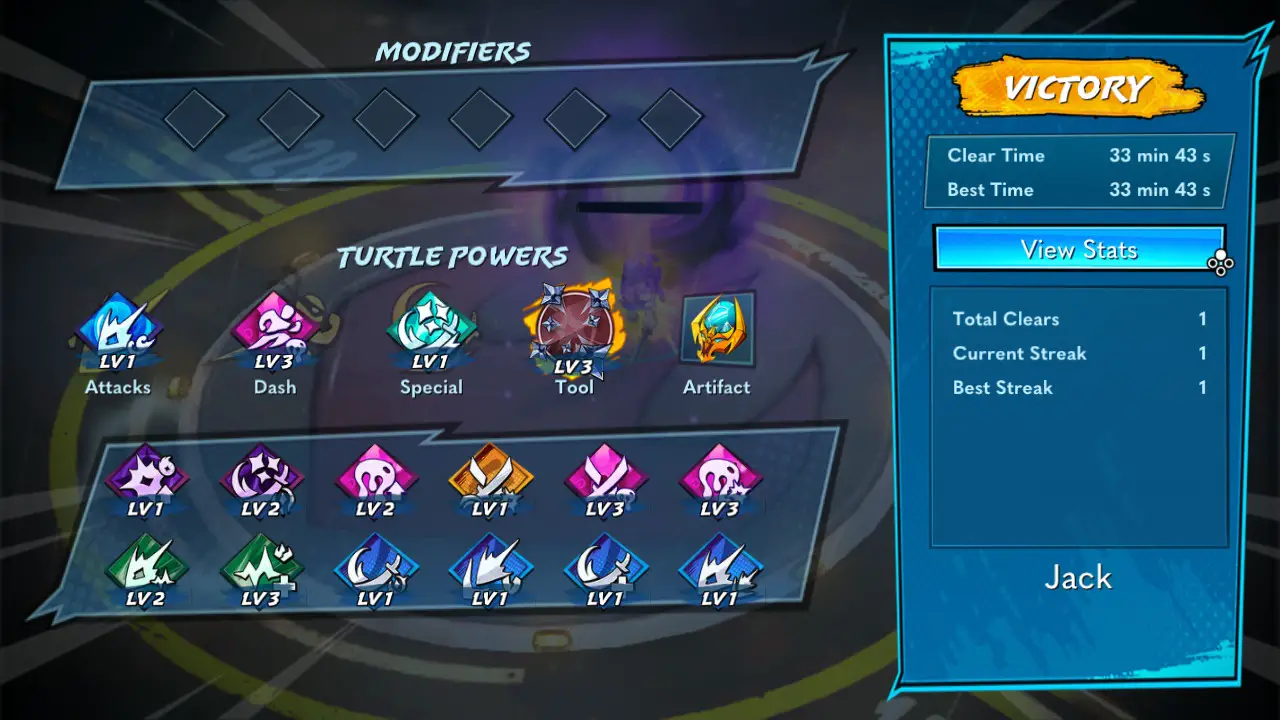If the Teenage Mutant Ninja Turtle arcade beat-em-ups of old aimed to (allegedly) munch your quarters, Splintered Fate (undoubtedly) aims to munch your time. No judgment, at least yet, but we need to face that fact. Splintered Fate doesn’t test a player’s skill so much as their persistence. It keeps you playing time and time again for reasons not entirely within your control. This decision brings with it both short-term advantages and long-term consequences.
To put this another way, Splintered Fate isn’t “fair.” Most things in life aren’t, but Splintered Fate especially. Playing well enough to reach the end on your first try isn’t realistic. If you’re a fan of TMNT’s arcade legacy, that should sound familiar, but the execution changes things. Arcade games function almost like playing a song: the learning curve may be steep, but performing well is both possible and rewarding once you’ve built up the requisite skill. Splintered Fate, similar to other “roguelikes,” feels more like listening to a song on repeat that changes a little each time. Despite the fact you technically take an active role in playing the game, there’s a disillusioning sense of passiveness that colors the experience.
Of course, the reality of Splintered Fate only sinks in when you dive deeper into it; on the surface it does everything you’d expect from a TMNT game. The game primarily focuses on what the Turtles do best: moving from screen to screen beating up on enemies. You view the action from an isometric perspective, which allows plenty of opportunity to fill the screen with enemies and their attacks. In addition to the all-important “whack enemy” button, the Turtles also have a dodge, a special attack, and ninja tools to help cover the holes in their offense and defense. Each of these extra options must recharge between uses, making them function more like strategic extras than full-on extensions of your arsenal.
These factors combine to create a combat system that hits all of the right notes (and ninjas). The principles of the combat are reminiscent of more typical TMNT beat-em-ups while logically extending them with more modern design principles, like the invincible dodges and cooldown timers. Everything about Splintered Fate’s combat fundamentals makes sense and makes for a solid, good time.
Sooner or later though, the good times will abruptly end. All of the different combat options suggest that players can develop a mastery of the game’s mechanics that will carry them past whatever challenges they face. That is true, but only in a loose sense. Different enemies throw out specific attack patterns you can learn and dodge, yet mastering them functions more like a basic prerequisite for playing than a genuine challenge. You can do a little better or a little worse based on your raw skill; you’ll still eventually hit a roadblock.
For me, roadblocks appeared primarily in the form of circular “damage zones” that the tougher enemies and bosses like to spam. Whether they take the form of electric currents, fiery trails, hazardous goo, or enemy projectiles, things can quickly get out of hand. The core challenge of the game lies in your ability to manage avoiding these damage zones while also landing hits on your enemies. Depending on the wave of enemy the game throws at you, this is much easier said than done. Many enemy combinations leave virtually no room for you to counterattack for grueling amounts of time. Their attacks will become so damaging or the area will become drenched so thoroughly with damage zones that any attempt to survive becomes overly tedious at best or impossible at worst. It’s simply not fun to even consider competing with this game’s idea of difficulty on the core merits of the combat alone.
Instead, you need to rely on various bonuses and upgrades to give you an edge. In between rounds of enemies, the game offers you a choice from randomly selected powerups, which can range from simple stat buffs to the ability to inflict status effects on your foes. These goodies only apply to your current “run” through the game. As you progress through a run, the game also rewards you with various currencies that can be exchanged for permanent upgrades that carry over across multiple runs. These upgrades skew the odds in your favor much more heavily, as they will boost vital stats and resources that keep you competitive with the endgame foes.
The idea here is that you need to play through the game several times to actually reach the end. Splintered Fate splinters itself into four main levels differentiated primarily by the environment and types of enemies you’ll face. As you’d expect, the game gets harder the further you get, but even the longest runs won’t take too much time. The fast pace of each run encourages you to keep coming back a little stronger thanks to the permanent upgrade systems in place, eventually becoming strong enough to overcome whatever initially unfair challenges present themselves.
Regardless of whether or not it’s legitimately impossible to prevail on skill alone, the feeling of unfairness cracks Splintered Fate’s seemingly sturdy outer shell. Splintered Fate fails to sell the idea that your active inputs in playing actually matter. When I died, I never thought “if only I had played a little better.” Instead I thought “if only I had been a little luckier.” Maybe if I had been given a different selection of powers, or my luck-based power ups activated more frequently, or perhaps if the enemies weren’t given such an annoying modifier, things would have turned out differently. All of these what ifs sit just outside your direct control, transforming the player into more of a passive observer along for the ride. The only way to gain control is to keep playing.
A sense of strategy and depth lurks behind the subsystems of upgrades, but you need to sink time into multiple runs to curb the randomness. Unlockable artifacts will limit the pools of power ups you can get and then be strategically swapped out for different pools later in the run. When combined with dice items that allow you to shuffle the random selection of powers available within those pools, Splintered Fate gives you the means to develop specific builds and strategies. This is the real point of the game; the actual game mechanics serve more as a pretense.
I see the appeal here: Splintered Fate gives the player numerous tangible measures for progress regardless of your performance. No matter how good or bad you do, the time you spent playing wasn’t wasted because you can start the next run better prepared than the last with new upgrades. This can be an appealing prospect, especially for those without much experience in playing games.
Unfortunately, the balance felt off to me. An ideal version of this game’s concept would emphasize the importance of builds and upgrades without totally undermining the importance of skill. Ironically, in making its intentions to avoid wasting your time so transparent, Splintered Fate imparts a sinking feeling that the game as a whole is made to waste your time. When I prevailed on a run, I couldn’t shake the feeling that my success was arbitrary. Victory lacks a truly rewarding sense of accomplishment or learning curve that most games thrive on. For some that may be fine, but I found little to look forward to after reaching the end of the game.
What do you do after you beat the game? Well, you beat it again. Splintered Fate asks you to complete it several times to reach the actual conclusion. As far as “replay value” goes, Splintered Fate offers a nice amount of incentives to keep you going. Completing the game adds additional twists to the structure like the option to take on restrictions for greater currency payouts or the option to challenge harder bosses, all to arguably keep further playthroughs interesting. I gave the game plenty more goes, but I wasn’t interested.
It’s a shame, because I found plenty to like beyond the gameplay itself. Splintered Fate’s interpretation of the TMNT loosely resembles their IDW comic book incarnation, which are some relatively fresh stomping grounds for video games. Both the aesthetics and narrative try very hard to engage you with the world of the TMNT in a detailed way that most video game adaptations underemphasize. When combined with a soundtrack that evokes the sounds of the beat-em-ups and cartoons without literally recreating them, Splintered Fate is one of the most cohesive and loving interpretations of the TMNT in video game form yet. I just wish I could appreciate the whole package!





















